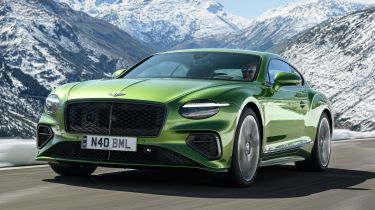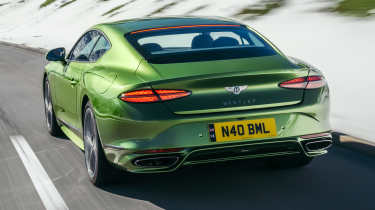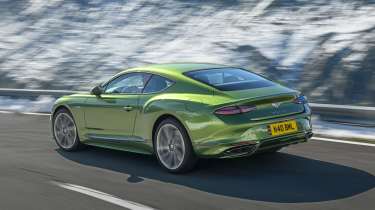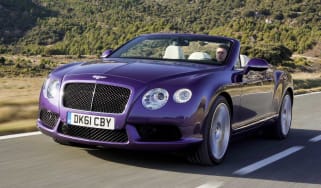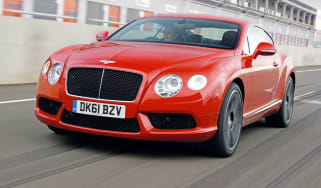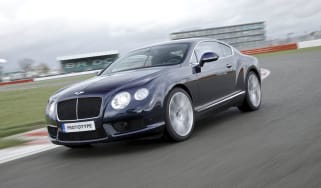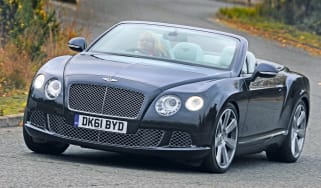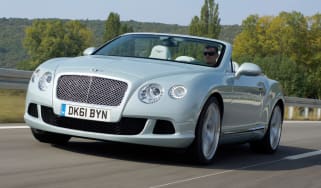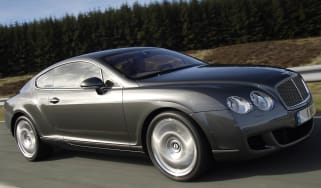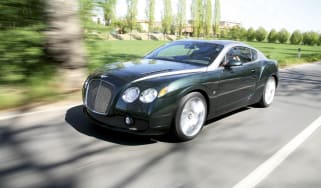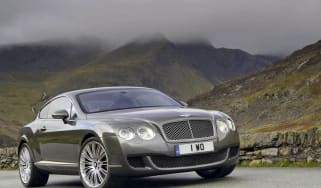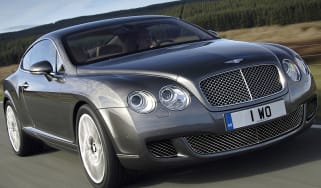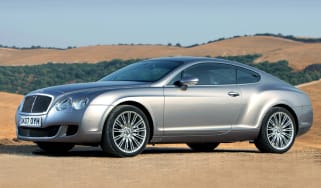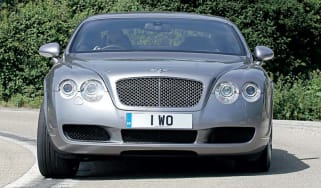Bentley Continental GT review
Bentley’s new plug-in powertrain is a perfect match for the bruising Continental GT, creating the most compelling grand tourer on the market

Is the Bentley Continental GT a good car?
Ditching the previous W12 engine and utilising a plug-in hybrid V8 powertrain in the Bentley Continental GT might seem a detrimental move, but in practice, the latest Continental GT is better in every measurable aspect. Electric assistance helps the V8 engine feel extraordinarily powerful and responsive, while retaining a burbly, menacing character. That reduced fuel consumption and a useful 50 miles of EV range come as part of the package only feels like a bonus on top of what is already an exceptional, world-beating GT.
| Key specs | |
| Fuel type | Petrol, plug-in hybrid |
| Body style | 4-seater GT coupe |
| Powertrain |
4.0-litre V8, twin-turbocharged, eight-speed dual-clutch auto, plus electric-motor, 25.9kWh battery pack, all-wheel drive |
| Safety | N/A |
| Warranty | 3yrs/unlimited miles |
How much does the Bentley Continental GT cost?
Think of a modern grand tourer and the Bentley Continental GT might just be the first car to spring to mind. The classic, four-seat luxury coupe first arrived in 2003, but now some 20 years on, this latest and greatest iteration might just represent the biggest leap in its genealogy so far. Based on a considerable update to the third-generation Continental GT launched in 2018, the new model doesn’t just introduce some new tech and styling, but also a wholesale change to the powertrain that brings this most traditional of models right up to the 21st century.
Launching the revised range from the top down, the flagship Speed is the first of this new era, and is priced from £236,600 in coupe form; that’s an increase of around £15,000 compared with the previous W12-powered Speed. However, this is but a starting point for most customers, because the scope for personalisation can take this price much, much higher.
Used - available now

2020 Bentley
Continental GT
29,000 milesAutomaticPetrol6.0L
Cash £89,995
2014 Bentley
Continental GT
42,000 milesAutomaticPetrol6.0L
Cash £36,495
2021 Bentley
Continental GT
33,950 milesAutomaticPetrol4.0L
Cash £134,995
2024 Bentley
Continental GT
23,900 milesAutomaticPetrol4.0L
Cash £129,950In fact, Bentley says that 75 per cent of all of its orders now dip into the bespoke Mulliner program, whether that be for specific paint, leather or stitching. Of course, Mulliner is now in the comprehensive coachbuilding business with the Batur and Bacalar model lines, but this enthusiasm for personalisation on the more mainstream Continental GT is largely what’s driving up Bentley’s average sale price, much to the delight of the company and its partners.
More iterations of the refreshed Continental GT will arrive in time, with Mulliner and S models destined to join the range from 2025 and beyond. We don’t yet know what powertrains will be offered in these, but they will almost certainly run as plug-in hybrids, just like the Speed. The GTC Convertible has also been released alongside the coupe, so too a more subtly updated Flying Spur saloon.
Engines, performance & drive
| Model | Power | 0-62mph | Top speed |
| Bentley Continental GT Hybrid | 771bhp | 3.2 seconds | 208mph |
Read between the lines and you will spot a few similarities between the plug-in hybrid powertrain in the updated Bentley Continental GT and the latest Porsche Panamera Turbo S-Hybrid – which is no bad thing. At the heart of the Continental GT is a 584bhp, twin-turbocharged 4.0-litre V8 engine, augmented by a 187bhp electric motor mounted within the eight-speed dual-clutch transmission’s casing.
The motor draws energy from a 25.9kWh battery pack mounted under the boot floor, and is capable of driving the GT solely on electric power for up to 50 miles. But the story goes beyond just having an impressive electric range, because this powertrain is more multi-dimensional than most run-of-the-mill plug-ins.
That’s thanks to this new high performance type of plug-in being designed to increase performance, just as much as it is to improve fuel economy. On start-up, a default ‘B’ mode will run the car in e-mode for a majority of the time, keeping the engine idle until a high load is requested. The same is true for ‘Comfort’ mode, and both drive just like any high-end electric car. That is to say that the powertrain is near-silent, and still offers just about enough performance to feel effortless. But it’s in ‘Sports’ mode where the Speed feels its best.
Twist the drive mode selector to its extreme left and the V8 engine will fire instantly. It’s now that the plug-in module will act more as a boost to the engine, adding in a sizeable chunk of power and torque to the powertrain. In this mode, the battery will retain its state of charge through regenerative braking and charging directly from the engine, and ensure that the maximum 771bhp and 1,050Nm of torque is available at any point.
Put your foot down and the electric motor’s punch is able to fill the lower part of the rev range, making the V8 engine feel supernaturally torquey and responsive right from tickover. Despite the considerable mass to shift, performance is off the scale, and seems to shrink the big GT as it rips through the relatively short ratios of the eight-speed transmission.
But there’s a further benefit to introducing electrical assistance to the V8 engine, because this has allowed Bentley’s engineers to give it an even more brutish character. The engine is simpler than the existing pure-ICE variant, since it does without fuel-saving elements like cylinder deactivation, and with the torque-filling ability of its e-motor, the turbochargers are now single rather than twin-scroll.
This reduction of fuel-saving trickery within the combustion engine itself has given the V8 a cleaner and more authentic engine note – both inside the cabin and out. Where the previous Continental GT V8 S would elicit a distant ‘woofle’, the latest car’s louder baritone bark makes more of an impression.
Traction is not a consideration, because the all-wheel drive system is able to efficiently deliver all the power to the road without any drama, even in slippery conditions. A full-throttle standing start on slippery tarmac during our test led to a brief moment of slip from all four wheels before they hooked up and the car felt every bit as rapid as Bentley’s claimed 3.2-second 0-62mph time.
All this performance is pointless if it’s not able to be controlled, however, and this is where Bentley’s full arsenal of chassis tricks come into play. Containing the Speed’s 2,459kg is a clever 48-volt active anti-roll system, four-wheel steering set-up, an electronically controlled limited-slip differential, and a full torque-vectoring system across both axles and from left-to-right.
These systems are all derived from the previous generation and do an admirable job of keeping the body level and controlled, but it’s actually the suspension which has seen a considerable upgrade.
Bentley has ditched the previous triple-chamber air springs for a set-up of dual-valve dampers and double-chamber springs. Bentley told us this isn’t so much for the benefit of road-holding, however, rather to make this edition more comfortable than previous models.
While it was a little tricky to ascertain the Speed’s ultimate ride comfort on smooth Swiss tarmac (and keeping in mind the intimidating Swiss speed limits), there’s definitely more compliance to the ride. In previous Continental GT models, it could struggle with sharp potholes and intrusions, often sending vibrations up through the cabin.
Stopping so much mass at high speeds is a critical factor, so the standard 420mm cast iron front brakes and 10-piston calipers are suitably sized, but the cars we drove were fitted with the optional 440mm carbon-ceramic brakes.
In both cases, Bentley has introduced new hardware between the brake pedal and the calipers, largely solving the often tricky job of blending regenerative and friction braking systems into the one motion. There is some variation to brake feel between drive modes; ’Comfort’ and ‘B’ modes will both regen the brakes when off the throttle, compromising pedal travel, but when driving in ‘Sport’ mode, pedal feel and consistency are good.
The steering is also precise and well weighted, with a Bentley-typical heft at low speeds that suits the size and scale of the car. There’s not a huge amount of true feel, but it combines well with the rear-wheel steering which itself feels very well calibrated and largely transparent – a best-case scenario for such a system.
MPG, emissions & running costs
| Model | MPG | C02 | Insurance group |
| Bentley Continental GT Hybrid | 27.4mpg | 29g/km | 50 |
Bentley quotes an on-paper efficiency rating of 27.4mpg on the combined WLTP cycle, which has recently been fiddled to better represent real-world figures for plug-in hybrid powertrains like that in the Continental GT.
This puts a higher reliance on the petrol engine in testing, and is reflected in the 27.4mpg figure quoted – for context, a similarly powerful Porsche Panamera Turbo S E-Hybrid on the old system has an on-paper figure of more like 200mpg. CO2 emissions are closer, though, rated at just 29g/km, which will have a positive impact on tax implications.
We didn’t quite match these numbers in our test car, with the on-board trip computer showing more like 19mpg. However, the test route was on a very mountainous section of Swiss Alpine roads, and we had the car largely in Sports mode, which does not prioritise efficiency.
If you have access to low-cost charging, and run the car in the more efficient modes, there’s no reason this figure won’t skyrocket, since the 50-mile EV range is higher than the average distance driven daily by many. Even on longer journeys, the electric motor’s ability to drive the car without the V8 engine’s input makes urban and motorway driving effortless – with the added bonus of being totally silent.
Fuel aside, though, running costs will be high. Expensive 22-inch Pirelli P Zero tyres are the original fitment, and consumables like brake pads and discs are also a consideration. The optional carbon-ceramic brakes ‘should’ last the life of the car, but they still are susceptible to wear.
Design, interior & technology
One of the biggest draws of the Bentley Continental GT has typically been its beautifully crafted interior, and the same is true with the latest iteration. Given that this is a considerable update of the previous car, rather than an all-new model, the cabin’s architecture is largely the same as before, yet comes with more than enough small updates to keep it fresh and desirable.
Inherently, the simply stunning build quality and palette of materials are still second to few in the industry, with a mixture of leathers, fabrics, metals and woods that each bring a sense of wonderful tactility to the experience. These overlay tremendous build quality with bank vault-like solidity to every moving part, be that the doors, glovebox or even the cup-holder lid.
There’s a good mix of digital interfaces and physical controls, with a main control suite situated around the transmission lever on the centre console. This represents a material change from the last generation, with its high-gloss black and metal combination of buttons replaced for a more subtle matte-grey finish. This small change might lack the sparkle it once did, but it also eliminates fingerprint marks and the occasional reflection of bright sunlight in the previous car.
Speed models are available with a bespoke interior colour split, and the main colour can be offset by small highlights of contrasting leather around the seat edges and under the dash top’s leading edge. You can specify some truly wild combinations, including the blue and orange combo of our test car, but it’s so customisable that one can also choose something much more demure.
The veneer options have been expanded, too. You’re able to specify everything from a classic selection of gloss veneers like dark-stained burr walnut or fiddleback eucalyptus, to technical finishes like turned aluminium, carbon fibre or even gloss-painted panels if you wish to do a full-colour block effect.
Sat-nav, stereo and infotainment
Bentley’s main changes inside are reserved to the digital interfaces, because both the main infotainment screen and digital driver’s displays have been revamped. The main infotainment system is a light update on the system that came before, borrowing much of its menu structure and functionality with various Porsche models.
What you need to know is that screen response is excellent, the graphics clear and integration of smartphone mirroring very well executed. Wireless Apple CarPlay and Android Auto are standard, but if you do rely purely on the embedded system, you still have full online traffic and support.
Outside of the screen there are still lots of physical shortcut buttons, plus a full bank of controls for the climate and seat functions. The rotating screen is also still around, and it’s just as much of a party piece as it was back in 2018.
Bentley’s reputation for superb high-end audio also continues, with three levels of system available. The first upgrade is a Bang & Olufsen system with 16 speakers, but for true audiophiles, the full Naim system with its 2,200W 18-speaker set-up is just about the biggest and most powerful in the business.
Our test cars were fitted with such a system and the sound quality was fantastic, as you’d expect, with rich tones and warm, enveloping bass.
The other digital interface, and the one that makes an even bigger impact, is the driver’s display. This is now both more variable in its customisation and its resolution far higher than before. Unlike the central screen, which uses a reskinned Porsche set-up, the driver’s display is closer in structure to high-end Audi models. Once again, this is no bad thing, because Audi does these things well, and the same is true for the Continental GT.
Boot space, comfort & practicality
| Dimensions | |
| Length | 4,895mm |
| Width | 2,187mm |
| Height | 1,397mm |
| Number of seats | Four |
| Boot space | 260 litres |
Despite a relatively large footprint on the road, the Continental GT isn’t quite the most spacious four-seat coupe in the class, because the second row can be a little tight on both legroom and headroom for tall passengers. However, the accommodation here is just as opulent as in the front, with top-class materials and plenty of places to store small items.
Overall comfort across both rows is excellent, too, since the changes to the suspension have been focused on making the Continental GT (particularly the Speed version we drove) more comfortable, rather than more dynamic. This can be felt in the supremely impressive ride comfort and excellent sense of refinement.
Road noise is close to completely absent, as is wind noise. Noise suppression is another highlight, although there is still plenty of burble from the V8 engine that enters the cabin, and none of it is acoustically augmented, as Bentley was keen to point out.
Where the GT struggles compared with the old car is boot capacity, because the battery pack has eaten into the boot space quite substantially. The high load lip is typical of this type of car, but the boot floor is now level with it, reducing boot capacity from 358 litres to a rather pokey 260. This is still enough to fit a set of golf clubs in, but it will be a squeeze.
There is a load-through function, which is handy for long items like ski bags and the like, but that still isn’t a huge amount of space inside this car considering its generous proportions.
Safety & reliability
| Key standard safety features |
Euro NCAP safety ratings |
|
|
It's unlikely that safety experts Euro NCAP will ever crash test a Bentley Continental GT, but there’s no reason to assume the latest model wouldn't safeguard you well considering it has plenty of passive and active safety systems as standard. In terms of reliability, a modern Bentley is a complicated creature, so there is a lot to go wrong. However, these are generally used as daily drivers, and few, if any reliability issues have been noted.
Because the new model has a totally new plug-in hybrid powertrain, this might change. But Bentley’s extensive development period, not to mention Porsche co-developing the system, does mean it has benefitted from some of the most exhaustive development processes in the business.
Bentley Continental GT alternatives
Bentley’s main rivals in the two-door GT space are all highly rated and come in lots of new forms, but few take comfort and refinement quite so seriously. Aston Martin, perennial British rival for generation after generation, has a new DB12, but it takes a decidedly more dynamic approach with its more focused chassis set-up. It’s also smaller inside, and doesn’t quite have the same all-round competence as the Bentley, despite weighing some 600kg less. It is far more dynamically engaging, though.
Ferrari’s Roma is one step further towards the sporting end of the spectrum, although its general ride quality is still better than the stiff-legged Aston Martin. It is even lighter, more compact and engaging to drive than the Aston, although the classic styling and elegant proportions do still make it a desirable choice for the GT buyer; so long as you don’t need to fit humans in the second row.
On the other side of the grand touring spectrum from Italy is the Maserati GranTurismo Trofeo. This is far more comfortable than both the Ferrari and Aston Martin, while offering more space inside than the Bentley and a more attainable price point. It’s also all-wheel drive, like the Continental GT, but comes with only six cylinders and with it a much lighter feeling on the road. This isn’t to say it’s underwhelming. Maserati’s balance of comfort, engagement and agility is actually outstanding – but the Italian car feels less substantial than the brutish Bentley.
The Maserati can also be specified in an all-electric Folgore variant, which offers a rare combination of traits that have no less appeal. Performance is actually more impressive than in the petrol-powered Trofeo, although its relatively limited 280-mile range challenges its status as a grand tourer.
Finally, at the very top of the class is the Rolls-Royce Spectre. No doubt a bigger and more expensive car than all ‘normal’ GTs, it’s the benchmark for comfort and quality, but doesn’t score in terms of engagement, plus it too has a limited all-electric range.
Frequently Asked Questions
Fuel consumption in all plug-in hybrid cars can vary hugely in the real world, but it’s all down to how you use them. The Bentley’s relatively large 25.9kWh battery pack and 50-mile real-world range should mean the majority of day-to-day driving can be completed without the V8 ever having to be switched on, saving you lots of fuel, and money, in the process. If you do drive in ‘Sports’ mode, or utilise the full performance on offer, the opposite is true, and you’ll chew through fuel as you’d expect in a 2.5-tonne car with a V8 petrol engine.
On-paper figures are rated at 27.4mpg, which feels right if you regularly do long journeys and require the V8 petrol engine to run for stretches of motorway or A-roads. If you do shorter journeys and keep to the more efficient hybrid mode, that figure will be higher. If you rely on the V8 and drive mostly in Sports mode, it’ll go down.

